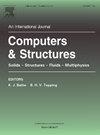相场断裂模型的时空自适应求解方案
IF 4.8
2区 工程技术
Q1 COMPUTER SCIENCE, INTERDISCIPLINARY APPLICATIONS
引用次数: 0
摘要
为了准确地捕捉裂纹的演化过程,需要对裂纹扩展区域进行更精细的网格划分,这导致相场模型的计算成本较高。为了提高计算效率,本文提出了一种时空自适应求解方案。采用自适应网格重划分技术,在空间场中自适应细化网格,将网格尺寸特征与相场变量相耦合,控制时间场的时间增量变化。该方案首先采用粗网格获取初始裂纹路径和单元能量分布,然后根据单元能量分布自动细化网格。其次,将空间场中网格尺寸的变化与相场变量的变化耦合起来,提出了时间场变化判据;时间增量根据网格尺寸和解域中相场值的变化自适应变化,减少了计算负担。通过算例验证了该方案的有效性。无论是单模态故障还是混合模态故障,自适应求解方案都能显著减少单元数和计算时间。同时,可以有效地模拟复杂裂纹轨迹,获得精确的载荷-位移曲线,为实际工程中复杂结构的失效分析提供了可能。本文章由计算机程序翻译,如有差异,请以英文原文为准。
A space–time adaptive solution scheme for phase field fracture model
To accurately capture the crack evolution, a finer mesh is required in the region of crack propagation, resulting in a higher computational cost for the phase field model. In order to improve the computational efficiency, a space–time adaptive solution scheme is proposed in this work. An adaptive remeshing technique is used to adaptively refine the mesh in the space field, the mesh size characteristics are coupled with the phase field variable to control the time incremental changes in the time field. In this scheme, a coarse grid is first used to obtain the initial crack paths and element energy distribution, and the mesh is automatically refined based on the element energy distribution. Second, the time field alteration criterion is presented by coupling the change of the mesh size in the spatial field with the change of the phase field variable. The time increment is adaptively varied based on the changes of mesh size and phase field value in the solution region to reduce the calculated burden. The proposed scheme is validated by some examples. Whether it is a single-mode failure or a mixed-mode failure, the adaptive solution scheme can significantly reduce the number of elements and the computation time. At the same time, complex crack trajectories can be effectively simulated and accurate load–displacement curves obtained, which makes it possible to use the phase field model to the failure analysis of complex structures in practical engineering.
求助全文
通过发布文献求助,成功后即可免费获取论文全文。
去求助
来源期刊

Computers & Structures
工程技术-工程:土木
CiteScore
8.80
自引率
6.40%
发文量
122
审稿时长
33 days
期刊介绍:
Computers & Structures publishes advances in the development and use of computational methods for the solution of problems in engineering and the sciences. The range of appropriate contributions is wide, and includes papers on establishing appropriate mathematical models and their numerical solution in all areas of mechanics. The journal also includes articles that present a substantial review of a field in the topics of the journal.
 求助内容:
求助内容: 应助结果提醒方式:
应助结果提醒方式:


